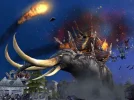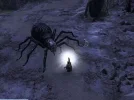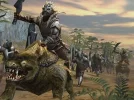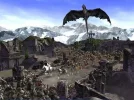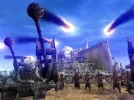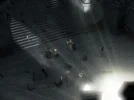It is always great to see what Electronic Arts has done with The Lord of the Rings movie license in an area filled with so many poor movie-based games. Their latest installment, however, is not a part of their 'hack'n'slash' series that was based on the second and third movies in the trilogy. Instead, this new game is a welcome addition to the strategy genre that truly captures Tolkien's world. This certainly is a new approach to this series of games, but luckily it holds its own in what has been a quite competitive genre this year.
Firstly, we should mention the fact that The Lord of the Rings: The Battle for Middle-Earth isn't necessarily revolutionary in any way when it comes to strategy games. It is much like any other RTS that you may have played in the past. So for those of you who are looking for a much different experience in a strategy game, then sadly this one may not be for you. With that said, it does have a few differences from your traditional RTS games which we'll mention throughout this review. As traditional strategy games go, you're given the opportunity to play a "Good Campaign" and an "Evil Campaign". Both campaigns involve different types of buildings, resources and soldiers. Both campaigns require different skills to win. So, for example, you ca not beat the "Good Campaign" in the same way you would win the "Evil Campaign". This does add some variety to the game and sure enough adds some more hours to the gameplay.
The "Good Campaign" allows you to control the armies of Rohan and Gondor in an attempt to destroy the One Ring. Occasionally, you'll have some missions where you just control the Fellowship of the Ring or some of its members. The members of the Fellowship can also be seen during some of the other battles. They are usually the strongest on the battlefield and are considered to be heroes. However, these heroes can be killed, and this is where a certain flaw seems to appear in the gameplay. If you kill a hero in an earlier battle, he may still appear in a later battle. Obviously this is to preserve the storyline of the game, but it does take the realism down a notch. If you do find that one of your heroes has been killed, all you have to do is just simply click on your main Citadel building and wait for him to be revived. Some of the heroes in this campaign are Gandalf, Gimli, Legolas, Aragorn, Frodo and many more. Heroes start at level 1, but can later upgrade to a maximum of level 10 making them more powerful. You'll can also fight in large battles such as Helm's Deep and Minas Tirith. The "Evil Campaign" allows you to take control of the evil forces of Mordor and Isengard. This gives you the opportunity to finally crush those tricksey Hobbitses. That's right, there's nothing like delivering a little bit of death and destruction to the lands of Middle-Earth. Some of the heroes that you control in this campaign include Saruman and the Nazgul. Obviously your heroes have more destructive powers on the side of evil. Also playing in this campaign, you can rely more heavily on your large number of Orc armies as opposed to being outnumbered and trying to survive in the "Good Campaign". This is just one way that both campaigns differ from each other in terms of gameplay.
Gameplay
Another main point that is different is the use of buildings. Buildings can always be built in the area of your bases on the Combat screen. The Combat screen is where you spend the majority of the game building, recruiting, and fighting the battles of Middle-Earth. In order to build a certain building, you must first capture a predetermined plot of land on the map. This spot can then either be constructed into a base or a resource building. Bases are constructed with a Citadel building in the middle that serves as the main building of the base, and must not be destroyed or else you will lose that base. Around the Citadel, are specific plots of land where you can build buildings such as archeries, stables and barracks for recruiting troops on the side of good. The side of evil allows you to create Orc and Troll pits for the creation of troops. Both sides have specific buildings to collect resources with farms being on the good side and slaughter houses and furnaces on the evil side. Much like any RTS, resources are needed to construct more buildings and troops. Both sides can also construct certain buildings that allow for upgrading armor and weapons. Even the buildings themselves can be upgraded to create more powerful troops.
Another area of the game that you'll spend very little time in is the overall Map area of Middle-Earth. The map shows the whole land of Middle-Earth and the positions of armies around the lands. From here, you can get the overall look of this world. The game also sends you in a specific direction, albeit a very linear one, from here. The game will force you to fight certain battles and to engage in certain missions. Only occasionally will it allow you to choose certain battles in whatever order you decide to fight them. This was obviously done to coincide with the events of the movies and to make sure that nothing was out of place. However, this does create a very linear way of playing the game, since you are told where to fight. Once you are given, or sometimes choose, where to fight, your view will zoom into the Combat screen where you can start fully playing the game. Upon conquering the areas in the Combat screen, you will see the lands that you have conquered turn your colour on the Map screen. Also, conquering certain lands will either gain you new troops and allies or command and power points. Another interesting factor is that when you create your troops on the Combat screen, they can be upgraded through fighting many battles or by giving them heavier armoir or banner upgrades.
Fighting out the battles isn't very different from any other RTS. Simply clicking on a squad of troops and commanding them to attack an enemy squad will initiate a battle. They will fight their enemies automatically if they get too close. One great thing about The Battle for Middle-Earth is something that is absent from almost every other strategy game: the liveliness of your troops. They actually feel like real living creatures. They'll chant and ready themselves for battle, and after the battle has been won, they will cheer for joy. This is a very welcome design in a genre where other games just have the troops mindlessly standing there after they have defeated their enemies. Another thing worth mentioning about the battles is that they aren't really very big. What should have been a huge battle at Minas Tirith with thousands of troops turned into only a few hundred. So the battles are nowhere near as large as what we have previously seen from Rome: Total War. This is quite disappointing as it would have been great to see larger scale battles like the movies.
Another thing to aid you in your battles are special powers. These powers can be bought throughout the game by spending special points that you earn from combat and completing missions. Both sides have their own special powers. Some are passive powers that are applied automatically (such as stronger troops), and other powers are used by activating them at any given time. After activating them, they will need some time to recharge. The people of Middle-Earth can have powers such as calling for Rohan reinforcements, calling for Elf reinforcements, calling upon the help of eagles, healing troops on the ground, calling upon the help of the Ents and the army of the dead and a few more. The forces of Mordor can use powers such as a war chant, calling upon the help of the Balrog, creating freezing rain and darkness, and the ability to control Saurons eye and move it throughout the land giving your troops strength and making your enemies cower in fear. These powers can be a great help in times of need. Lastly, The Battle for Middle-earth allows you to decide the fate of Middle-Earth online. You are able to choose which side to fight for and where to fight. Although we did notice some rather large slowdowns online, it is still fun to watch the forces of Mordor fighting against the forces of Mordor. There's nothing quite like watching some Nazgul fighting Nazgul.
The graphics in The Battle for Middle-Earth are gorgeous, but fall short due to a somewhat limited camera system. The graphics definitely capture Tolkien's world in terms of architecture and atmosphere thanks to the Command and Conquer: Generals engine being used here. The only problem is that the camera doesn't let you zoom in as far as you would like. Instead it tends to linger up higher and will not allow you to get directly into the action. You can control the camera to fully look around the world, but it lacks the ability smoothly pan up and down. Also, when fighting on larger battles, such as Minas Tirith, the camera tends to 'lock' itself onto the different levels of the city when you are moving it. This does tend to get annoying and doesn't allow you to see the battle in its entirety.
The voiceovers and sound effects sound like they've been directly extracted from the movies. In fact, the whole cast has lend their voices for their roles in this game. The sound effects are greatly detailed and allow you to hear the screeching roar from the Nazgul, the cheers of the soldiers, and the chanting of the Orc armies. It is truly an area of the game that brings out the full realism of this world and makes you feel like you are listening to one of the movies.
Not much can be said about the AI: it is quite simple. It seems as if it's main design is to just build a base, create new troops and attack you at any moment. Its simple design does have an overall realistic effect in larger battles and feels somewhat realistic. However, this can get quite monotonous when trying to conquer smaller pieces of land.
Conclusion
The Lord of the Rings: The Battle for Middle-Earth is a welcome addition into The Lord of the Rings franchise. It comprises a traditional RTS style of gameplay whilst incorporating Tolkien's magnificent world of Middle-Earth beautifully. Luckily, it's flaws can be overlooked in certain cases. Although it may not be perfect, nor does it bring anything new to this genre, it is still one game that any fan of this series should be willing to check out.
Firstly, we should mention the fact that The Lord of the Rings: The Battle for Middle-Earth isn't necessarily revolutionary in any way when it comes to strategy games. It is much like any other RTS that you may have played in the past. So for those of you who are looking for a much different experience in a strategy game, then sadly this one may not be for you. With that said, it does have a few differences from your traditional RTS games which we'll mention throughout this review. As traditional strategy games go, you're given the opportunity to play a "Good Campaign" and an "Evil Campaign". Both campaigns involve different types of buildings, resources and soldiers. Both campaigns require different skills to win. So, for example, you ca not beat the "Good Campaign" in the same way you would win the "Evil Campaign". This does add some variety to the game and sure enough adds some more hours to the gameplay.
The "Good Campaign" allows you to control the armies of Rohan and Gondor in an attempt to destroy the One Ring. Occasionally, you'll have some missions where you just control the Fellowship of the Ring or some of its members. The members of the Fellowship can also be seen during some of the other battles. They are usually the strongest on the battlefield and are considered to be heroes. However, these heroes can be killed, and this is where a certain flaw seems to appear in the gameplay. If you kill a hero in an earlier battle, he may still appear in a later battle. Obviously this is to preserve the storyline of the game, but it does take the realism down a notch. If you do find that one of your heroes has been killed, all you have to do is just simply click on your main Citadel building and wait for him to be revived. Some of the heroes in this campaign are Gandalf, Gimli, Legolas, Aragorn, Frodo and many more. Heroes start at level 1, but can later upgrade to a maximum of level 10 making them more powerful. You'll can also fight in large battles such as Helm's Deep and Minas Tirith. The "Evil Campaign" allows you to take control of the evil forces of Mordor and Isengard. This gives you the opportunity to finally crush those tricksey Hobbitses. That's right, there's nothing like delivering a little bit of death and destruction to the lands of Middle-Earth. Some of the heroes that you control in this campaign include Saruman and the Nazgul. Obviously your heroes have more destructive powers on the side of evil. Also playing in this campaign, you can rely more heavily on your large number of Orc armies as opposed to being outnumbered and trying to survive in the "Good Campaign". This is just one way that both campaigns differ from each other in terms of gameplay.
Gameplay
Another main point that is different is the use of buildings. Buildings can always be built in the area of your bases on the Combat screen. The Combat screen is where you spend the majority of the game building, recruiting, and fighting the battles of Middle-Earth. In order to build a certain building, you must first capture a predetermined plot of land on the map. This spot can then either be constructed into a base or a resource building. Bases are constructed with a Citadel building in the middle that serves as the main building of the base, and must not be destroyed or else you will lose that base. Around the Citadel, are specific plots of land where you can build buildings such as archeries, stables and barracks for recruiting troops on the side of good. The side of evil allows you to create Orc and Troll pits for the creation of troops. Both sides have specific buildings to collect resources with farms being on the good side and slaughter houses and furnaces on the evil side. Much like any RTS, resources are needed to construct more buildings and troops. Both sides can also construct certain buildings that allow for upgrading armor and weapons. Even the buildings themselves can be upgraded to create more powerful troops.
Another area of the game that you'll spend very little time in is the overall Map area of Middle-Earth. The map shows the whole land of Middle-Earth and the positions of armies around the lands. From here, you can get the overall look of this world. The game also sends you in a specific direction, albeit a very linear one, from here. The game will force you to fight certain battles and to engage in certain missions. Only occasionally will it allow you to choose certain battles in whatever order you decide to fight them. This was obviously done to coincide with the events of the movies and to make sure that nothing was out of place. However, this does create a very linear way of playing the game, since you are told where to fight. Once you are given, or sometimes choose, where to fight, your view will zoom into the Combat screen where you can start fully playing the game. Upon conquering the areas in the Combat screen, you will see the lands that you have conquered turn your colour on the Map screen. Also, conquering certain lands will either gain you new troops and allies or command and power points. Another interesting factor is that when you create your troops on the Combat screen, they can be upgraded through fighting many battles or by giving them heavier armoir or banner upgrades.
Fighting out the battles isn't very different from any other RTS. Simply clicking on a squad of troops and commanding them to attack an enemy squad will initiate a battle. They will fight their enemies automatically if they get too close. One great thing about The Battle for Middle-Earth is something that is absent from almost every other strategy game: the liveliness of your troops. They actually feel like real living creatures. They'll chant and ready themselves for battle, and after the battle has been won, they will cheer for joy. This is a very welcome design in a genre where other games just have the troops mindlessly standing there after they have defeated their enemies. Another thing worth mentioning about the battles is that they aren't really very big. What should have been a huge battle at Minas Tirith with thousands of troops turned into only a few hundred. So the battles are nowhere near as large as what we have previously seen from Rome: Total War. This is quite disappointing as it would have been great to see larger scale battles like the movies.
Another thing to aid you in your battles are special powers. These powers can be bought throughout the game by spending special points that you earn from combat and completing missions. Both sides have their own special powers. Some are passive powers that are applied automatically (such as stronger troops), and other powers are used by activating them at any given time. After activating them, they will need some time to recharge. The people of Middle-Earth can have powers such as calling for Rohan reinforcements, calling for Elf reinforcements, calling upon the help of eagles, healing troops on the ground, calling upon the help of the Ents and the army of the dead and a few more. The forces of Mordor can use powers such as a war chant, calling upon the help of the Balrog, creating freezing rain and darkness, and the ability to control Saurons eye and move it throughout the land giving your troops strength and making your enemies cower in fear. These powers can be a great help in times of need. Lastly, The Battle for Middle-earth allows you to decide the fate of Middle-Earth online. You are able to choose which side to fight for and where to fight. Although we did notice some rather large slowdowns online, it is still fun to watch the forces of Mordor fighting against the forces of Mordor. There's nothing quite like watching some Nazgul fighting Nazgul.
The graphics in The Battle for Middle-Earth are gorgeous, but fall short due to a somewhat limited camera system. The graphics definitely capture Tolkien's world in terms of architecture and atmosphere thanks to the Command and Conquer: Generals engine being used here. The only problem is that the camera doesn't let you zoom in as far as you would like. Instead it tends to linger up higher and will not allow you to get directly into the action. You can control the camera to fully look around the world, but it lacks the ability smoothly pan up and down. Also, when fighting on larger battles, such as Minas Tirith, the camera tends to 'lock' itself onto the different levels of the city when you are moving it. This does tend to get annoying and doesn't allow you to see the battle in its entirety.
The voiceovers and sound effects sound like they've been directly extracted from the movies. In fact, the whole cast has lend their voices for their roles in this game. The sound effects are greatly detailed and allow you to hear the screeching roar from the Nazgul, the cheers of the soldiers, and the chanting of the Orc armies. It is truly an area of the game that brings out the full realism of this world and makes you feel like you are listening to one of the movies.
Not much can be said about the AI: it is quite simple. It seems as if it's main design is to just build a base, create new troops and attack you at any moment. Its simple design does have an overall realistic effect in larger battles and feels somewhat realistic. However, this can get quite monotonous when trying to conquer smaller pieces of land.
Conclusion
The Lord of the Rings: The Battle for Middle-Earth is a welcome addition into The Lord of the Rings franchise. It comprises a traditional RTS style of gameplay whilst incorporating Tolkien's magnificent world of Middle-Earth beautifully. Luckily, it's flaws can be overlooked in certain cases. Although it may not be perfect, nor does it bring anything new to this genre, it is still one game that any fan of this series should be willing to check out.

